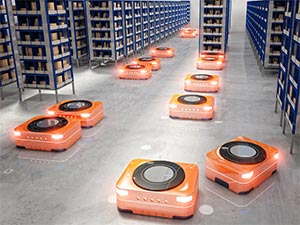 Glenn Powell, General Manager of CoGri Australia PTY Ltd and Face Consultants PTY Ltd, explains how the warehouse of the future will embrace robotic technology, and the essential components these multi-level, low ceiling height warehouses will require.
Glenn Powell, General Manager of CoGri Australia PTY Ltd and Face Consultants PTY Ltd, explains how the warehouse of the future will embrace robotic technology, and the essential components these multi-level, low ceiling height warehouses will require.
Almost every day there is an article posted about the next technology that is going to change the logistics industry. Our thirst for a better deal is fuelling e-commerce as more consumers turn to online shopping over retail, especially since the Covid 19 virus outbreak. eRetailers on the other hand battle it out to win your business by promising lower prices, faster deliveries and a safer shopping experience.
Our city centres are changing, and shops of the future will be more of a showroom for the goods you will buy online, rather than selling you the end product. Augmented Reality (AR) will no doubt be a big contributor to this change as you will simply hold up your phone or tablet and be able to explore in detail your future purchase whether it be a new item of clothing, a piece of furniture, or your favourite food.
Whilst all of this is terribly exciting, yet at the same time somewhat frightening, whatever the future holds there is no denying the logistics industry is changing at a breath-taking pace so, is your warehouse ready for these changes?
What is the warehouse of the future?
 The warehouse of the future may look nothing like it is today. For example, an Amazon fulfilment centre is vastly different to a conventional warehouse. Instead of a single level, high ceiling box-style building, it is now a multi-level, low ceiling height warehouse where small robots replace high reach forklift trucks.
The warehouse of the future may look nothing like it is today. For example, an Amazon fulfilment centre is vastly different to a conventional warehouse. Instead of a single level, high ceiling box-style building, it is now a multi-level, low ceiling height warehouse where small robots replace high reach forklift trucks.
Where multi-storey department stores once stood and thousands of people shopped, these have been replaced, in some cases, by multi-level fulfilment centres because they are close to conurbations. Robotic fulfilment centres do not need conventionally high clearance ceilings, so this type of building is relatively easy to convert into a modern distribution centre.
Fear of jobs being lost to robotics is a genuine one but there is a misconception that a robotic warehouse gets rid of people and jobs. This is often not the case, as many hundreds or, in some cases, thousands of people are still required, even in a fully automated warehouse. Obviously, as technology is refined further this may change and reduce the requirement of people but for the moment at least, automated warehouses still need people.
What are the requirements of an automated warehouse?
- Is your warehouse close enough to serve your customers?
- Can your warehouse be converted to a higher density
- Will AMRs (Autonomous Mobile Robots), ASRS (Automated Storage & Retrieval Systems), Cabots (Collaborative Robots), or AGVs (Automated Guided Vehicles), be able to operate safely and efficiently?
facility, be that multi-level or very narrow aisle (VNA)?
Start with the most important components
One of the most important components of any warehouse is the floor. Ask most distribution centre managers what matters most to their operation and they will usually answer, ‘does my roof leak and is the floor OK?’ People are obviously important too, but if your roof leaks and your floor is not able to service your customers, then the business really starts to suffer.
Robotics, VNA, AGVs, ASRS and even conveyors, all put greater demands on the warehouse floor than ever before. An existing warehouse floor may not be suitable for automated systems without some form of rectification or compromise. Newer developments don’t necessarily fare any better, and can be at more of a risk, being unable to service automation due to lean slab designs, which have been engineered to the limits. When robotics is added to the equation the demands on the floor change even further, with some requiring very specific requirements such as:
- Surface Gloss;
- Friction;
- Abrasion Resistance;
- Levelness;
- Flatness;
- Surface Resistivity; and even Roughness.
No longer is it just loads and flatness that is important for a warehouse floor, the demands on the floor are more complicated and challenging than ever before.
Creating the perfect automated warehouse floor
Whether you are considering ASRS, robotics, VNA, AGVs or just want a better floor, designed and constructed for the future, speak to us. We can help unravel the complexities and tell you, in plain English, what it means to your business to ultimately protect your investment.
A structural engineer may understand the design and the loads but marrying the materials handling equipment (MHE) and floor together takes a different level of understanding. The earlier you engage a specialist consultant, like Face Consultants (who lead the way in floor flatness testing for robotics), the greater your chances of success and the lower the risk to your project.
For further information please visit our Flooring Services for G2P page

Glenn Powell
Glenn Powell is the General Manager of CoGri Australia PTY Ltd and Face Consultants PTY Ltd. With over 14 years experience in the concrete flooring industry, Glenn’s experience spans design, testing and construction of industrial warehouse, distribution and fulfilment centres. Glenn has extensive experience with existing concrete floors be that upgrades, repairs and make good solutions.Contact Glenn and his team today or follow us on LinkedIn:
Glenn Powell - LinkedIn
Face Consultants - LinkedIn
